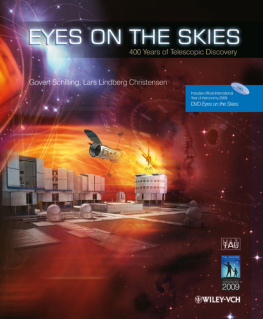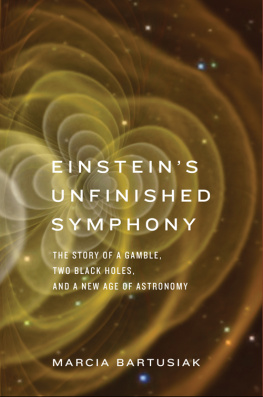1. Introduction
There is no way to know who first surveyed the sky: it may not even have been a human. From experiments in planetaria we know that migrating birds recognize the rotation of the sky, and it has been reported that dung beetles can navigate by the light of the Milky Way.
With the naked eye we can see the Sun, the Moon, five planets, and around 1,000 stars. Although the nighttime skys appearance changes from hour to hour and month to month, the relative positions of the bright stars hardly change over generations. The constellation patterns we see today are almost identical to those observed by the ancient Babylonians thousands of years ago, and there are stars that have had the same name for millennia.
But while the sky doesnt change much, the tools that are available to astronomers do. Ever since Galileo first used his telescope, astronomers have been searching out new ways to scan the heavens, and each new technology has led to the discovery of new kinds of object. The telescope led to the discovery of nebulae, radio telescopes led to the discovery of quasars, infrared astronomy gave us protostars, while X-ray astronomy revealed black holes.
Most of present-day professional astronomy is actually astrophysics. We focus on finding out what things are made of, how they became the way they are, how they interact with each other, and how they will behave in the future. But pure astronomy still exists in the form of the search for new objects and new phenomena, and it is by conducting new kinds of surveys of the sky that our science is continually being reborn.
1.1 The Five Eras of Astronomy
There are many different ways to describe the history of astronomy, but a particularly useful one is to focus on new technology as a major trigger for progress. This approach leads us naturally to divide astronomy into five distinct historical eras. When a new era begins there is a need and an enthusiasm to survey the sky by some new method.
The Naked Eye Era This goes from prehistoric times up to the invention of the telescope in the 17th century. This era is covered in Chapter
The Telescope Era During this era, which began with Galileo, astronomers could look at the sky through telescopes, but had to record what they saw by hand. The number of catalogued stars rose from about a thousand to nearly a million. Asteroids, nebulae, and planetary moons were added to the pantheon of cosmic phenomena. This era is covered in Chapter
The Photography Era The third era is dominated by the introduction of astrophotography around 1880, allowing astronomers to obtain permanent records of what they saw, and to detect much fainter objects than those visible through an eyepiece. The greatest events in the photography era were the discovery of the nature of galaxies, and the understanding of the physics of stars. The photography era is covered in Chapter
The Electromagnetic Era Until Janskys radio experiments in the 1930s all astronomy was done using visible light, except for small extensions into the ultraviolet, and infrared regions that were made possible by special photographic plates. Radio astronomy blossomed soon after World War II, but the opening up of the X-ray, gamma-ray, ultraviolet and infrared wavebands started in the 1960s, largely as a by-product of the space race. Once it was established that there was science to be done in these wavebands, astronomers built instruments to survey the sky, pinpointing objects that were worth studying in more detail with specialized telescopes. These surveys are covered in Chapters
The CCD Era With the ever-increasing sophistication of solid-state digital cameras, and the ever-decreasing cost of digital technology, we are now firmly in the fifth era of astronomy, where sources are being discovered by the billions mainly, but not exclusively, by once again using ground-based telescopes at visible wavelengths. Telescopes fitted with large digital cameras, such as Pan-STARRS in Hawaii, are programmed to methodically and repeatedly scan the sky and record their results in vast digital databases. Part of the motivation for these surveys is to look for moving and changing objects in the sky, such as potentially hazardous asteroids, but the databases are also gold mines for the discovery and study of stars and galaxies. More and more astronomy is now being performed by making digital searches within these databases rather than traveling to a mountain-top observatory to collect new data. This era is covered in Chapter
1.2 Defining a Survey
There are five main factors that define the properties of an astronomical survey: wavelength, sky coverage, angular resolution, sensitivity, and time-variability. Each of the surveys described in this book has involved a major innovation or improvement in at least one of these factors.
Wavelength
The single most important factor in a survey is the wavelength at which it is conducted. As Figure shows, there is now an enormous range of electromagnetic waves that are accessible to astronomers. The ratio between the longest and shortest wavelength observations is now a factor of 1021. In the photographic era the ratio was about 3, and in the naked-eye era it was less than 2.
Fig. 1.1
The electromagnetic spectrum currently available to astronomers. As discussed in Appendix A.3, astronomers usually use photon energy rather than wavelength to describe X-rays and gamma rays
Since the Earths atmosphere is opaque over wide ranges of the electromagnetic spectrum the choice of wavelength will usually determine whether the survey will be conducted from the ground or from a space-borne telescope. All X-ray observations, plus many infrared, ultraviolet, and gamma-ray observations, must be made from space, but most visible-light and radio observations can be done from the ground at a much lower cost.
A survey will often be performed simultaneously at two or more wavelengths, because the ratio of an objects brightness at different wavelengths, which we would call the color in the case of visible light, is often a powerful guide to the physical nature of the object under study.
Sky Coverage
On a cloudless night at sea-level a telescope can view half of the universe: the other half is below its horizon. As the Earth rotates and orbits the Sun other parts of the sky become temporarily visible, but unless the telescope is situated exactly on the equator there will always be parts of the universe that never rise above its horizon. Many surveys accept this limitation and confine themselves to more or less half of the sky, but there are a few, including the 2MASS survey (section ), which employ two telescopesone in each hemisphere.
Another solution to the horizon problem is to go into space. An Earth-orbiting survey telescope that spends part of its orbit in the northern hemisphere and part in the south can potentially observe the whole sky, so long as it stays in orbit long enough that the Sun is not always in front of the same constellation. A few satellites, including WMAP (section ), have been placed into a special Lagrangian orbit that takes them around the Sun rather than the Earth.
Other factors may come into play when considering the sky coverage of a survey. If the surveys main purpose is to study distant galaxies, as is the case with the Sloan Digital Sky Survey (section ), there is not much point in making observations in the direction of the Milky Way. Likewise, most searches for asteroids will be concentrated in the plane of the ecliptic.











